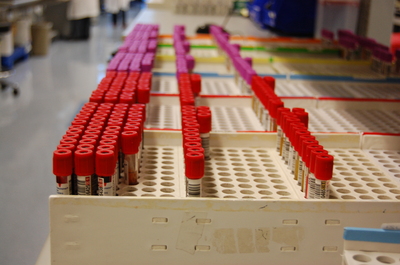What happens in the lab?
| Tweet |
By Tim Gilmore, Blood Drive Account Manager, Stanford Blood Center
During each blood donation, six small tubes of blood are collected (to be used later for testing), along with the bag of blood used for transfusion. When the blood donors finish their good deed, they rest in the canteen with cookies and juice. But their precious gift of blood is already busy, working toward saving lives! Here, we take you on a tour through our lab.
Once the blood has been drawn, the bag and tubes are properly sealed and stored in coolers. Shuttle drivers pick up the blood and deliver it to the Stanford Blood Center laboratory.
At the lab, everything is scanned into our system. At this point, tubes and bags are separated for testing/processing. Tubes must be tested and approved before the corresponding unit of blood can be released for use.
At Stanford Blood Center, we test for:
ABORh Type
Cytomegalovirus (CMV)
Hepatitis B
Hepatitis C
Syphilis
HIV
HTLV-I/II
T-Cruzi
West Nile Virus
Note: For the most current list of tests performed, visit this page on our site.
Processing comes next. The first step is to separate the unit of whole blood into different components. Doing this allows our hospitals to give patients exactly what they needand nothing extra. Blood components are separated through the use of a centrifuge machine.
Once out of the centrifuge machine, the unit will have broken down into the four basic components of blood – red cells, plasma, platelets and white cells. White cells can be harmful if transfused into a patient, so are filtered out or used for research.
Red blood cells are refrigerated and can be kept for a maximum of 42 days. Plasma is frozen and can be stored for up to a year if not immediately needed. Platelets have the shortest shelf life; they last only about three days after the testing is complete.
Next, our staff reviews hospitals’ orders and sends the blood components where they need to go.
Finally, hospital employees transfuse the blood products into people who need blood to survive or thrive.
If you’re interested in a group tour of our labmaybe with a class at school, a group of friends, or a few co-workersjust let us know and we’ll arrange it. Contact: Kevin O’Neill (kvoneill@stanford.edu, 650-725-2540).

